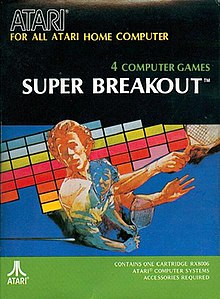Loading AI tools
1978 video game From Wikipedia, the free encyclopedia
Super Breakout is a sequel to the 1976 video game Breakout released in arcades in September 1978 by Atari, Inc.[4] It was written by Ed Rotberg.[2] The game uses the same mechanics as Breakout, but allows the selection of three distinct game modes via a knob on the cabinet—two of which involve multiple, simultaneous balls in play.[4] Both the original and sequel are in black and white with monitor overlays to add color. It was distributed in Japan by Namco and Esco Trading.
| Super Breakout | |
|---|---|
 Atari 8-bit box cover | |
| Developer(s) | Atari, Inc. Paradox (ST) |
| Publisher(s) | Arcade Ports Atari, Inc. (2600, 5200, Atari 8-bit) Atari UK (ST) Majesco (Game Boy) |
| Designer(s) | Ed Rotberg |
| Programmer(s) | Arcade[2] Ed Rotberg Atari 2600[2] Nick Turner Carol Shaw Atari 8-bit[2] Larry Kaplan Game Boy[2] David Lubar |
| Platform(s) | Arcade, Atari 2600, Atari 5200, Atari 8-bit, Atari ST, Game Boy, Game Boy Color |
| Release | September 1978: Arcade[3][4] 1979: Atari 8-bit 1981: Atari 2600 1982: Atari 5200 1987: Atari ST 1998: Game Boy, GB Color |
| Genre(s) | Breakout |
| Mode(s) | Arcade, 2600, 5200 1–2 players alternating turns Atari 8-bit 1–8 players alternating turns[5] |
The arcade game was commercially successful in Japan and the United States. Atari published home versions–in color–for most of its consoles and computers and was the pack-in game for the 1982 release of the Atari 5200 console.
The fundamental gameplay—use a paddle to bounce a ball into a wall of destructible bricks—is the same as Breakout, but Super Breakout contains three different game modes:
Double gives the player control of two paddles at the same time—one placed above the other—with two balls in-play simultaneously.
Cavity also has two paddles, but initially only one ball. Two others are contained in pockets inside the wall and can be freed.
Progressive advances the entire wall downward step by step, gaining in speed the longer the ball is in play.
The game was written by Ed Rotberg, who later designed Battlezone (1980) for Atari.[2] Rotberg developed Super Breakout after hearing that Atari founder Nolan Bushnell wanted Breakout updated.[6] While the original was constructed with discrete logic instead of a microprocessor, Super Breakout uses a MOS Technology 6502 CPU. Like Breakout, Super Breakout uses a black and white display with overlays to simulate color.[4]
Super Breakout appeared as a cartridge for Atari 8-bit computers in 1979 with support for up to 8 players taking turns.[5] A port for the Atari VCS (later renamed the Atari 2600) was available at the end of 1981, initially as a Sears exclusive release under the Tele-Games branding.[7] An Atari branded version was then released in January 1982.[8] The VCS port includes two "Children's Version" games that require less skill to play. Four years after release, Super Breakout became the pack-in game for the then-new Atari 5200 console in 1982. Prior home versions use paddle controllers; the 5200 port uses the system's analog joysticks.
An Atari ST version developed by Paradox was published by Atari UK in 1987.[9] Majesco released Super Breakout for the Game Boy in 1998 and Game Boy Color in 1999. Both the Atari ST and Game Boy versions have sculpted bricks similar to those of the Breakout-inspired Arkanoid.[9]
All of the home ports also include a version of the original Breakout game.[10]
In Japan, it was the ninth-highest-earning arcade video game of 1978.[11] In the United States, it was the eighth-highest-earning arcade video game of 1979.[12] Atari sold a total of 4,805 Super Breakout arcade cabinets.[3]
In regard to Super Breakout being included with every Atari 5200, David H. Ahl of Creative Computing Video & Arcade Games, wrote in 1983:
We thought this a somewhat curious choice since it hardly uses the higher resolution of the 5200 to great advantage. The screen, for example, has the same number of bricks as Super Breakout on the Atari VCS. However, users of the VCS will like the much better representation of alphanumerics on the 5200.[13]
In 1995, Flux magazine ranked Super Breakout 93rd on their "Top 100 Video Games".[14]
For Kid Stuff Records, John Braden recorded a 7-in 331⁄3 RPM record telling the story of Super Breakout. This science fiction story dealt with NASA astronaut Captain John Stewart Chang returning from a routine mission transporting titanium ore from Io to space station New California. He encounters a rainbow barrier, presumably a force of nature, that seems to have no end on either side. He has three lobbing missiles of white light that he can bounce off the hull of his shuttle, and they prove able to break through the layers of the force field. With his life support systems failing, what follows is a test of endurance turned game as he strives to break through the barrier in space.[15]
Glu Mobile released a licensed cellular phone version.[16] In 2008, Atari released the game for the iPhone and iPod Touch via Apple's App Store.
Seamless Wikipedia browsing. On steroids.
Every time you click a link to Wikipedia, Wiktionary or Wikiquote in your browser's search results, it will show the modern Wikiwand interface.
Wikiwand extension is a five stars, simple, with minimum permission required to keep your browsing private, safe and transparent.